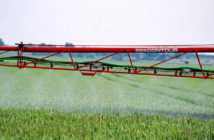With spring crop fertiliser applications typically applied straight after drilling, growers who team residual herbicide adjuvant Backrow Max with their pre-emergence herbicide, may not only see improved weed control but could also benefit from improved fertiliser uptake, according to new research.
To explore the concept, Interagro commissioned the Institute of Soil Science and Plant Cultivation in Poland to research the influence of Backrow Max on the movement of nitrogen fertiliser in the soil in the form of ammonium nitrate and urea ammonium nitrate at rates of 120 kg/ha.
Soil cores (30cm deep and 6.7cm in diameter) were taken from an arable field in Wroclaw using a Van der Horst core sampler. The cores were analysed and the soil texture was found to be 73% sand, 18% silt and 7% clay, with a pH of 6.4 and maximum water-holding capacity of 61.2%.
The soil cores were then treated with Backrow Max in a stationary spraying chamber at a water volume of 200 l/ha. After 3 hours, the fertiliser treatments were applied. “Urea was applied directly, while the ammonium nitrate was first ground and dissolved in water – in a volume equal to the urea dose – to make the nitrogen more readily available,” explains Mr Sutherland.
Irrigation was started 20 hours after the fertiliser application with a volume equivalent to 20 ml of rain and repeated every second day. One day after the last irrigation event (equivalent to 5 ml of rain) – day 11 – the soil profiles were extruded and cut into pieces at 0-5 cm, 5-10 cm and 10-20 cm. The experiments were carried out in three replicates. All core samples were then analysed for their nitrate and ammonium levels.
Where Backrow Max was applied to soil before the fertiliser application, nitrate retention in the upper soil profile was higher and there was significantly less nitrate recorded in 5-10cm and 10-20 cm cores compared with the soil that hadn’t received Backrow Max. The movement of ammonium through the soil profile was also significantly reduced with the Backrow Max holding significantly more in the top 5cm for both the ammonium nitrate and UAN fertilisers.
“While we’re not suggesting farmers apply Backrow Max with their fertiliser, if they are applying a pre-em and the spring turns wet, adding Backrow Max into the mix could certainly help improve the targeting of fertiliser applications, a good thing for the farmer and the environment,” notes Mr Sutherland.
Wider water benefits
For Chris Hewis, catchment advisor for Anglian Water, the ability of adjuvants to reduce the movement of herbicide and nitrate to water is hugely valuable.
He notes how quickly Anglian Water finds chemicals in the water after spraying. Resulting in costly treatment to reduce rates down to the legal minimum, so instead water companies are actively trying to work with farmers to look at and facilitate putting tools in place to avoid chemistry entering the watercourses in the first place, he says.
“Over the past year we’ve seen increasing levels of nitrates in water levels which has meant we’ve had to stop abstractions or not been able to fill reservoirs when we’ve wanted to, so it’s really important to avoid this as much as we can.”
Some of the measures for best practice include creating buffer strips or sowing cover crops so that nutrients are held in the field longer, says Mr Hewis. “Adjuvants are also another example of a tool that can help keep products in the field, but also provide a mutual benefit for farmers.
“If products stay in the field longer, not only can we reduce spikes in the watercourses, but farmers are also getting more benefit from the product they’ve spent out on.”




